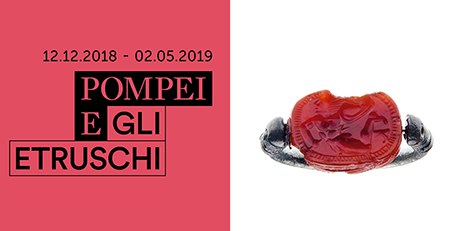'Pompeii and the Etruscans' is the major exhibition at the Large Palaestra of the Pompeii Excavations, which will follow the exhibitions on Egypt in 2016 and Greece in 2017, and which will address the controversial and complex question of 'Campanian Etruria', and of the relationships and cultural exchanges between elite Campanian Etruscans, Greeks and indigenous peoples, at the heart of which was Pompeii. The Pompeian exhibition complements the events promoted by the Archaeological Museum of Naples dedicated to the rediscovery of the Etruscan Civilisation through the tastes of antique dealers and collectors, which is scheduled for the 31st May 2019.
Around 800 finds coming from Italian and European museums, displayed in 13 rooms which have been arranged in the northern portico of the Large Palaestra, allow a broad look at the Etruscan culture, from the earliest Etruscan influences in Campania before Pompeii, until Pompeii itself - a new Etruscan city in a multi-ethnic Campania, until its sunset, and the memory of certain Etruscan customs which were preserved for some time.
Materials in bronze, silver, terracotta and ceramic from tombs, sanctuaries and dwellings allow us to analyse and compare diverse elements in order to address the controversial dynamics of the Etruscan presence in Campania.
The core of the exhibition is formed by the finds which were brought to light by the recent excavations in the extra-urban sanctuary of Fondo Iozzino - which was one of the main sanctuaries (in addition to those of Apollo and Athena) founded at Pompeii at the end of the 7th century BC - which themselves have yielded a large quantity of material from the Archaic Age, including weapons and vessels for ritual libations with inscriptions in the Etruscan language. In the exhibition, these materials are flanked by those coming from other Etruscan cities in Campania - primarily Pontecagnano and Capua - where there were important sites of worship, with characteristics similar to that of Fondo Iozzino.
As evidence of sumptuous princely tombs, in which members of the most important of the grand aristocratic families, we have the grave goods from Artiaco Tomb 104 of Cumae, of a cosmopolitan prince (the remains of the cremated deceased were deposited in a silver cauldron, in the manner of the heroes described in Homer's Iliad: “He ate and drank like a Greek, yet wore clothes and bore arms of Etruria, and acted as an Oriental king”.); as well as those of a princess of Montevetrano (Tomb 74), near Pontecagnano; and those of a sumptuous tomb of a prince of the Orientalizing Period from Lazio (The Barberini Tomb of Palestrina).
The dynamics of the meetings of cultures, the integration of social groups and the role of the Mediterranean as a place and theatre of fluid cultures and isolated identities have constituted the leitmotif of the exhibitions at the Large Palaestra of Pompeii, which began with the exhibition regarding Egypt, then Greece and now Etruria.
Since the end of the nineteenth century, Campania has appeared to be a melting pot of presences, to historical and antiquarian sciences. The arduous task of unraveling the bundle of overlapping groups and ethnicities thus fell to archaeology, with its array of philological instruments and objects.
In this sense the exhibition, like its predecessors, is a research path coming from a program which has been active for some years, is divided into excavation, study and documentation projects. What emerges from this operation is the concept of an ancient and multi-ethnic Campanian territory - one that is therefore open to influences and change, which forms the primary basis for the progress of a civilisation. Pompeii, which in the first centuries of its life was undoubtedly one of the structural foci of the region, has now become a model for investigating the form of the archaic cities of Campania.
The exhibition is curated by Director General Massimo Osanna and Stéphane Verger, Directeur d'études à l'École Pratique des Hautes Etudes, and is promoted by the Archaeological Park of Pompeii, with the support of the National Archaeological Museum of Naples, the Polo Museale of Campania and the Polo Museale of Basilicata and is organised by Electa.
Access to the exhibition is included in the admission fee for the excavations.


